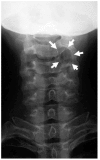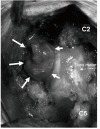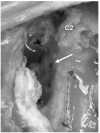Postoperative meningitis in patients with cervical cord tumor: a case report
- PMID: 21165319
- PMCID: PMC2996627
- DOI: 10.4184/asj.2010.4.2.136
Postoperative meningitis in patients with cervical cord tumor: a case report
Abstract
Postoperative meningitis after spinal surgery is a rare complication that can result in a life-threatening condition. Linezolid (LZD) is an oxazolidinone which has been approved in Japan for infections caused by methicillin-resistant Staphylococcus aureus. The authors encountered a case of postoperative meningitis with cerebrospinal fluid leakage (liquorrhoea) that occurred after resection of a cervical cord tumor. The infection was caused by methicillin-resistant Staphylococcus epidermidis(MRSE). Debridement and suture of the dura matter was carried out. LZD was given intravenously. The infection was cured without any sequelae. Based on this result, we concluded that LZD might be considered as one of the first choices for the treatment of postsurgical meningitis caused by MRSE.
Keywords: CSF leakage; Linezolid; Methicillin-resistant Staphylococcus epidermidis; Postoperative meningitis; Surgical site infection.
Figures





Similar articles
-
Treatment with linezolid in a neonate with meningitis caused by methicillin-resistant Staphylococcus epidermidis.Eur J Pediatr. 2013 Oct;172(10):1419-21. doi: 10.1007/s00431-013-1978-7. Epub 2013 Feb 26. Eur J Pediatr. 2013. PMID: 23440482
-
Effect of linezolid against postneurosurgical meningitis caused by methicillin-resistant Staphylococcus epidermidis: case report.J Infect Chemother. 2008 Apr;14(2):147-50. doi: 10.1007/s10156-007-0582-z. Epub 2008 Apr 30. J Infect Chemother. 2008. PMID: 18622679
-
Characterisation of clinical meticillin-resistant Staphylococcus epidermidis demonstrating high levels of linezolid resistance (>256 μg/ml) resulting from transmissible and mutational mechanisms.J Infect Chemother. 2015 Jul;21(7):547-9. doi: 10.1016/j.jiac.2015.03.012. Epub 2015 Mar 30. J Infect Chemother. 2015. PMID: 25913534
-
Staphylococcus aureus meningitis: case series and literature review.Medicine (Baltimore). 2010 Mar;89(2):117-125. doi: 10.1097/MD.0b013e3181d5453d. Medicine (Baltimore). 2010. PMID: 20517182 Review.
-
[Development of hospital pharmacy practice using therapeutic drug monitoring].Yakugaku Zasshi. 2014;134(9):949-55. doi: 10.1248/yakushi.14-00164. Yakugaku Zasshi. 2014. PMID: 25174365 Review. Japanese.
Cited by
-
Post-Traumatic Meningitis Is a Diagnostic Challenging Time: A Systematic Review Focusing on Clinical and Pathological Features.Int J Mol Sci. 2020 Jun 10;21(11):4148. doi: 10.3390/ijms21114148. Int J Mol Sci. 2020. PMID: 32532024 Free PMC article.
-
Coagulase-negative staphylococci (CoNS) meningitis: a narrative review of the literature from 2000 to 2020.New Microbes New Infect. 2020 Sep 7;37:100755. doi: 10.1016/j.nmni.2020.100755. eCollection 2020 Sep. New Microbes New Infect. 2020. PMID: 33014383 Free PMC article. Review.
-
When and How to Use MIC in Clinical Practice?Antibiotics (Basel). 2022 Dec 3;11(12):1748. doi: 10.3390/antibiotics11121748. Antibiotics (Basel). 2022. PMID: 36551405 Free PMC article. Review.
-
Surgical treatment for bacterial meningitis after spinal surgery: A case report.Medicine (Baltimore). 2017 Mar;96(11):e6099. doi: 10.1097/MD.0000000000006099. Medicine (Baltimore). 2017. PMID: 28296723 Free PMC article.
References
-
- Weinstein MA, McCabe JP, Cammisa FP., Jr Postoperative spinal wound infection: a review of 2,391 consecutive index procedures. J Spinal Disord. 2000;13:422–426. - PubMed
-
- Corti G, Cinelli R, Paradisi F. Clinical and microbiologic efficacy and safety profile of linezolid, a new oxazolidinone antibiotic. Int J Antimicrob Agents. 2000;16:527–530. - PubMed
-
- Viale P, Pagani L, Cristini F, et al. Linezolid for the treatment of central nervous system infections in neurosurgical patients. Scand J Infect Dis. 2002;34:456–459. - PubMed
-
- Nagashima G, Okamoto N, Okuda M, et al. Effect of linezolid against postneurosurgical meningitis caused by methicillin-resistant Staphylococcus epidermidis: case report. J Infect Chemother. 2008;14:147–150. - PubMed
LinkOut - more resources
Full Text Sources

